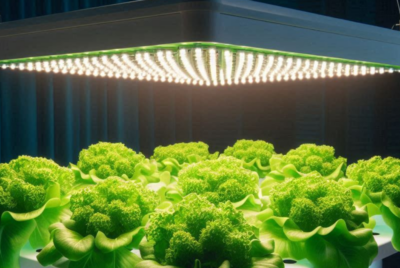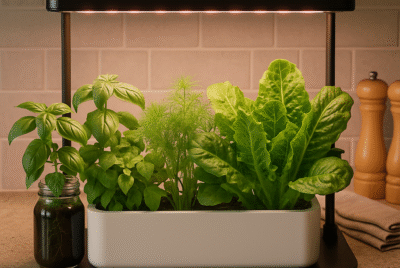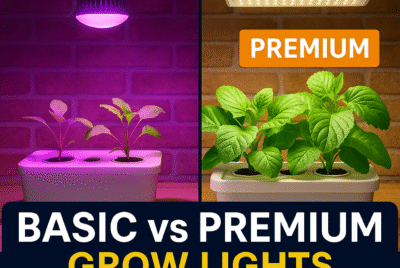5 Best Hydroponic Systems
What is Hydroponics?
Basic Definition
Hydroponics refers to a method of growing plants using a water-based nutrient solution without the use of soil. The plants’ roots are supported using an inert medium such as perlite, rock wool, clay pellets, or vermiculite.
Benefits of Hydroponic Gardening
The benefits of hydroponic gardening include:
1. Faster Growth Rates: Plants often grow 30-50% faster than those grown in soil.
2. Higher Yields: Hydroponic systems can produce more food per square foot than traditional gardening.
3. Water Efficiency: Hydroponics uses up to 90% less water compared to soil-based gardening, as water can be recycled and reused.
4. Space Efficiency: Ideal for urban settings, hydroponics allows for vertical farming, maximizing limited space.
5. Controlled Environment: Allows precise control over the nutrient balance and environmental conditions, reducing pest and disease issues.
How Hydroponics Differs from Traditional Soil Gardening
Unlike traditional soil gardening, hydroponics eliminates soil, which can harbor pests and diseases, and offers precise control over nutrients, water, and light, resulting in healthier plants. Hydroponic systems also reduce the need for pesticides and herbicides, making it an environmentally friendly choice.
Why Hydroponics is Gaining Popularity
Hydroponics is increasingly popular due to its efficiency, sustainability, and the growing interest in urban agriculture. It enables year-round cultivation, which is particularly valuable in areas with harsh climates or limited agricultural space.
Common Misconceptions About Hydroponics
Many believe hydroponics is too complex or expensive, but systems range from simple and affordable setups to advanced configurations, catering to all skill levels and budgets. Another misconception is that hydroponic plants are less natural or nutritious, but studies show they are often equal or superior in quality to soil-grown plants.
Types of Hydroponic Systems
Hydroponic systems vary widely in complexity, cost, and maintenance requirements. Here’s an overview of the most common types:
Nutrient Film Technique (NFT)
How NFT Works
In an NFT system, a shallow stream of nutrient-rich water flows continuously past the bare roots of plants housed in a sloped channel. The nutrient film provides essential nutrients and oxygen while the slope allows excess solution to drain back into a reservoir.
Pros and Cons
– Pros: Efficient nutrient delivery, low water usage, and suitable for leafy greens and herbs.
– Cons: Vulnerable to power outages, root diseases if not maintained properly, and not ideal for large plants.
Best Uses and Suitable Plants
NFT systems are best suited for small, fast-growing plants like lettuce, spinach, and herbs, which thrive in a constantly moist environment.
Top NFT Systems on the Market
1. Apollo Horticulture NFT Grow Kit
2. VIVOSUN Hydroponic Grow Kit
3. Hydrofarm Active Aqua Grow Flow System
4. General Hydroponics AeroFlo System
5. Viagrow Complete Hydroponic System
Tips for Maintaining an NFT System
– Regularly clean the channels to prevent root clogging and algae growth.
– Ensure a consistent flow of nutrients to prevent drying out.
– Monitor the water pump for uninterrupted operation.
Deep Water Culture (DWC)
How DWC Works
In a DWC system, plants are suspended above a nutrient-rich water solution with their roots submerged. An air pump oxygenates the water, preventing root rot and
promoting healthy growth.
Pros and Cons
– Pros: Simple to set up and maintain, promotes rapid growth, and is cost-effective.
– Cons: Risk of root rot if oxygenation fails, and not ideal for larger plants without additional support.
Best Uses and Suitable Plants
DWC is perfect for growing larger plants like tomatoes, cucumbers, and peppers, as well as leafy greens.
Top DWC Systems on the Market
1. HydroFarm Root Spa
2. General Hydroponics PowerGrow System
3. Active Aqua Hydroponic Bubble System
4. Emily’s Garden by Hydrofarm
5. Hydrofarm Oxygen Pot System
Tips for Maintaining a DWC System
– Regularly check and adjust the pH and nutrient levels.
– Ensure the air pump is working properly to maintain oxygen levels.
– Clean the reservoir to prevent algae and bacteria buildup.
Ebb and Flow (Flood and Drain)
How Ebb and Flow Works
Ebb and Flow systems work by periodically flooding the grow tray with nutrient solution, which then drains back into a reservoir. This cycle provides plants with nutrients and oxygen, mimicking natural tides.
Pros and Cons
– Pros: Versatile, supports a wide range of plant sizes, and easy to automate the nutrient flow.
– Cons: Requires regular maintenance to prevent clogs in the pump and drains, and is more complex than simpler systems like DWC.
Best Uses and Suitable Plants
Ebb and Flow systems are ideal for growing both small and large plants, including leafy greens, herbs, and flowering plants. They are particularly good for plants that prefer intermittent watering.
Top Ebb and Flow Systems on the Market
1. Hydrofarm MegaGarden Ebb and Flow System
2. Botanicare Ebb & Flow Kit
3. Active Aqua Grow Flow System
4. Viagrow Complete Ebb & Flow System
5. SuperPonics Ebb and Flow System
Tips for Maintaining an Ebb and Flow System
– Regularly clean and inspect the pump and drain to prevent clogs.
– Check the timer settings to ensure proper flooding and draining cycles.
– Monitor plant roots for signs of rot or nutrient deficiencies.
Wicking Systems
How Wicking Systems Work
Wicking systems are among the simplest hydroponic setups. They use a wick material, such as cotton or felt, to draw nutrient solution from a reservoir to the plant roots, much like a candle wick draws wax to the flame.
Pros and Cons
– Pros: Low cost, easy to set up and maintain, and no moving parts.
– Cons: Less efficient nutrient delivery, limited to smaller plants, and not ideal for fast-growing crops.
Best Uses and Suitable Plants
Wicking systems are best suited for small, water-loving plants like herbs and small vegetables. They are ideal for beginners or those with limited space and resources.
Top Wicking Systems on the Market
1. Mr. Stacky Wicking Planter
2. Viagrow Complete Wicking System
3. Exo Terra Water Dish Wick Kit
4. Dewitt 3-Pack Wicking Systems
5. GroBucket Wicking System
Tips for Maintaining a Wicking System
– Ensure the wick remains in contact with both the water and the plant roots.
– Regularly top off the nutrient solution to keep it at the proper level.
– Monitor for signs of nutrient buildup in the growing medium.
Aeroponics
How Aeroponics Works
In an aeroponic system, plants are suspended in air and their roots are periodically misted with a nutrient-rich solution. This system provides a high oxygen environment for roots, promoting rapid growth.
Pros and Cons
– Pros: Rapid growth rates, efficient water and nutrient use, and minimal medium required.
– Cons: High setup and maintenance costs, requires careful monitoring of misting cycles, and prone to technical failures.
Best Uses and Suitable Plants
Aeroponics is suitable for a wide range of plants, including leafy greens, herbs, and even some root vegetables. It’s ideal for those looking to maximize growth speed and yield.
Top Aeroponics Systems on the Market
1. Tower Garden Aeroponic System
2. AeroGarden Aeroponic Indoor Garden
3. General Hydroponics AeroFlo Aeroponic System
4. Nutraponics Tower Garden
5. AquaSprouts Garden
Tips for Maintaining an Aeroponics System
– Regularly clean and sterilize the misting nozzles to prevent clogs.
– Monitor and maintain proper nutrient solution levels and pH balance.
– Ensure reliable operation of the pump and misting schedule.
Choosing the Right System for You
Selecting the right hydroponic system depends on several factors, including your experience level, the space available, budget, and the types of plants you wish to grow.
Considerations for Beginners
Beginners should start with simpler systems like Wicking or Deep Water Culture, which require less maintenance and are easier to manage.
Factors to Consider: Space, Budget, Plant Type
– Space: Vertical systems like Aeroponics or Tower Gardens are excellent for maximizing limited space.
– Budget: Wicking and DWC systems are budget-friendly, while NFT and Aeroponics systems may require a larger initial investment.
– Plant Type: Consider what plants you want to grow. Leafy greens and herbs are well-suited for most systems, while fruiting plants may require more space and support.
Personal Recommendations
Based on my experience, the Aeroponics system offers the best results in terms of growth speed and yield, but it can be costly and complex. For those just starting, the Deep Water Culture system provides a good balance of simplicity and effectiveness.
Mistakes to Avoid When Starting Out
– Overcomplicating the Setup: Start simple and expand as you gain experience.
– Neglecting Maintenance: Regular cleaning and monitoring are crucial for healthy plants.
– Ignoring pH and Nutrient Levels: These are critical for plant health; always keep them in the optimal range.
How to Scale Your Hydroponic Garden
As you become more comfortable with hydroponics, consider scaling up by adding more grow units or upgrading to a more advanced system. Vertical systems or stacked setups can maximize space efficiency.
Top 5 Hydroponic Systems Reviews
1. AeroGarden Bounty Basic
Overview and Key Features
The AeroGarden Bounty Basic is a countertop hydroponic garden system perfect for beginners and hobbyists. It comes with an integrated grow light and a control panel that automates the watering and lighting schedule.
Pros, Cons, and User Ratings
– Pros: Easy setup, user-friendly, built-in LED grow lights.
– Cons: Limited space for larger plants, higher cost for a small-scale system.
Ideal Plant Types
Best for herbs, salad greens, and small vegetables.
Maintenance Tips
– Regularly check the water level and add nutrients as needed.
– Prune plants to avoid overcrowding and ensure even light distribution.
2. Hydrofarm MegaGarden
Overview and Key Features
The Hydrofarm MegaGarden is a compact Ebb and Flow system that supports up to 14 plants. It includes a 7-gallon reservoir, timer, and pump, making it ideal for both beginners and intermediate gardeners.
Pros, Cons, and User Ratings
– Pros: Versatile, accommodates a wide variety of plants, easy to use.
– Cons: Requires regular maintenance, can be noisy.
Ideal Plant Types
Suitable for a wide range of plants, including tomatoes, peppers, and herbs.
Maintenance Tips
– Ensure the timer and pump are functioning correctly.
– Clean the grow bed and reservoir periodically to prevent algae growth.
3. General Hydroponics WaterFarm
Overview and Key Features
The WaterFarm by General Hydroponics is a modular, efficient hydroponic system that uses a drip irrigation method. It’s designed for growing medium to large plants and can be expanded as needed.
Pros, Cons, and User Ratings
– Pros: Customizable, efficient water and nutrient delivery.
– Cons: Requires frequent monitoring, limited to a few plants per module.
Ideal Plant Types
Best for larger plants such as tomatoes, cucumbers, and peppers.
Maintenance Tips
– Check and clean the drip emitters regularly.
– Maintain the nutrient solution and pH levels.
4. Active Aqua Root Spa
Overview and Key Features
The Active Aqua Root Spa is a simple yet effective Deep Water Culture system designed for growing a variety of plants. It features a large reservoir and an air pump to oxygenate the nutrient solution.
Pros, Cons, and User Ratings
– Pros: Affordable, easy setup, promotes rapid growth.
– Cons: Requires frequent nutrient solution changes, limited to smaller plants.
Ideal Plant Types
Ideal for leafy greens, herbs, and small to medium-sized fruiting plants.
Maintenance Tips
– Regularly change the nutrient solution to prevent stagnation.
– Monitor the air pump and check for blockages in the air lines.
5. Tower Garden AeroGarden
Overview and Key Features
The Tower Garden is a vertical aeroponic growing system that maximizes space efficiency and is perfect for both indoor and outdoor use. It can grow up to 20 plants at once and is ideal for urban gardeners.
Pros, Cons, and User Ratings
– Pros: Space-saving, promotes rapid growth, suitable for a variety of plants.
– Cons: High initial cost, requires careful monitoring and maintenance.
Ideal Plant Types
Suitable for a wide range of plants, including leafy greens, herbs, strawberries, and small vegetables.
Maintenance Tips
– Regularly clean and maintain the pump and nozzles.
– Ensure consistent nutrient and water levels.
Tips for Successful Hydroponic Gardening
To get the most out of your hydroponic system, it’s essential to follow best practices and stay attentive to the needs of your plants. Here are some detailed tips for successful hydroponic gardening:
Monitoring pH and Nutrient Levels
Maintaining the correct pH and nutrient levels is crucial for plant health. Most hydroponic systems require regular checking and adjusting of the pH level, ideally between 5.5 and 6.5, to ensure nutrient availability.
1. Use a pH Meter: Invest in a reliable pH meter to accurately measure the pH of your nutrient solution.
2. Adjust with pH Up/Down Solutions: Use pH adjustment solutions to correct imbalances in your nutrient mix.
3. Monitor Nutrient Concentration: Regularly check the EC (Electrical Conductivity) to ensure your plants are receiving the right nutrient concentration.
4. Keep a Log: Maintain a log of pH and nutrient levels to track changes and make adjustments as needed.
5. Flush the System: Periodically flush the system with clean water to prevent nutrient buildup and ensure balanced nutrient delivery.
Lighting and Temperature Control
Proper lighting and temperature control are vital for maximizing plant growth and productivity.
1. Choose the Right Grow Lights: LED or high-intensity discharge (HID) lights are commonly used in hydroponics. Ensure they provide the full spectrum of light needed for plant growth.
2. Maintain Light Cycles: Different plants require different light cycles. Most leafy greens need about 12-16 hours of light per day, while fruiting plants may need up to 18 hours.
3. Control Temperature: Aim to keep the growing environment between 65-75°F (18-24°C) for optimal growth. Use fans, heaters, or air conditioners as needed.
4. Monitor Humidity Levels: Maintain humidity levels around 50-70% to prevent mold and mildew issues. Use dehumidifiers if necessary.
5. Adjust Light Height: Ensure that lights are at the proper height above plants to avoid light burn and provide adequate light intensity.
Choosing the Right Plants for Hydroponics
Selecting the right plants for your hydroponic system can significantly impact your success.
1. Start with Easy-to-Grow Plants: Beginners should start with leafy greens such as lettuce, spinach, and kale, which are well-suited for hydroponic systems.
2. Consider Growth Space: For larger systems, you can grow fruiting plants like tomatoes and peppers, which need more space and support.
3. Research Plant Requirements: Different plants have specific nutrient and light requirements. Ensure your system meets these needs.
4. Use Fast-Growing Varieties: Opt for fast-growing plants to see quicker results and learn more about hydroponics.
5. Experiment with Herbs: Herbs like basil, mint, and cilantro thrive in hydroponic systems and add variety to your garden.
Common Issues and Solutions
Hydroponic gardening can come with its own set of challenges. Here’s how to address common issues:
1. Nutrient Deficiencies: Symptoms include yellowing leaves or poor growth. Adjust nutrient levels and ensure proper pH balance.
2. Pest Problems: Although less common, pests like aphids and spider mites can still appear. Use natural pest control methods or insecticidal soap.
3. Root Rot: Often caused by overwatering or poor oxygenation. Ensure proper aeration and avoid letting the roots sit in stagnant water.
4. Algae Growth: Can occur in stagnant water. Use light-blocking covers or clean the system regularly.
5. System Failures: Regularly check all components (pumps, timers, lights) to prevent unexpected failures. Have backup equipment on hand.
Advanced Techniques for Maximizing Yields
For experienced hydroponic gardeners looking to take their setup to the next level, consider these advanced techniques:
1. Nutrient Film Technique (NFT) Expansion: Experiment with multiple channels and advanced nutrient solutions for increased productivity.
2. Vertical Gardening: Utilize vertical space by incorporating vertical hydroponic towers or shelves.
3. CO2 Enrichment: Increase growth rates and yields by adding CO2 to the growing environment.
4. Advanced Lighting Systems: Use programmable lighting systems that simulate natural sunlight cycles for optimized plant growth.
5. Automated Systems: Invest in automated nutrient delivery and environmental control systems to streamline maintenance and maximize efficiency.
Conclusion
Hydroponic gardening offers an innovative and efficient way to grow plants, providing numerous benefits such as faster growth rates, higher yields, and better resource use. By understanding the different types of hydroponic systems, considering your specific needs, and following best practices, you can achieve a thriving indoor garden.
Whether you choose a simple system like Deep Water Culture or a more advanced setup like Aeroponics, each system has its unique advantages and applications. Begin with a system that suits your experience level and space, and gradually explore more sophisticated options as you gain confidence.
Hydroponics is not just a method of gardening but a gateway to a more sustainable and productive way of growing food. Embrace the potential of hydroponics, and enjoy the rewarding experience of cultivating your own fresh produce right at home.
FAQs
What are the initial costs of setting up a hydroponic system?
The initial costs vary depending on the system. Basic setups like Wicking or DWC systems can start at around $50-$100, while more advanced systems like Aeroponics or NFT can range from $200 to $1000 or more.
Can I grow all types of plants using hydroponics?
While most plants can be grown hydroponically, some may require specific conditions. Leafy greens, herbs, and certain fruiting plants are commonly grown hydroponically. Research each plant’s requirements to ensure they match your system.
How often do I need to check the nutrient solution?
It’s important to check the nutrient solution at least once a week. Monitor the pH, nutrient concentration, and water levels regularly to ensure optimal plant health.
What are the most common problems in hydroponic gardening?
Common problems include nutrient deficiencies, root rot, algae growth, and system failures. Regular monitoring, maintenance, and proper setup can help prevent these issues.
Is hydroponic gardening sustainable?
Yes, hydroponic gardening can be very sustainable. It uses less water than traditional soil gardening, reduces the need for pesticides, and allows for year-round production, making it an environmentally friendly choice.
*We may earn a commission from purchases made through our links, at no cost to you. This does not affect our product recommendations. Please see our disclosure to learn more.




